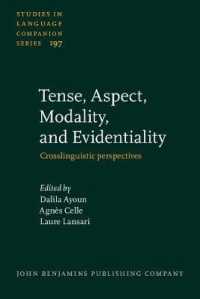- ホーム
- > 洋書
- > 英文書
- > Psychology
Full Description
Among the earliest volumes of this monograph series was a report by Lester Sontag and colleagues, of the esteemed Fels Institute, on the heart rate of the human fetus as an expression of the developing nervous system. Here, some 75 years later, we commemorate this work and provide historical and contemporary context on knowledge regarding fetal development, as well as results from our own research. These are based on synchronized monitoring of maternal and fetal parameters assessed between 24 and 36 weeks gestation on 740 maternal-fetal pairs compiled from eight separate longitudinal studies, which commenced in the early 1990s. Data include maternal heart rate, respiratory sinus arrhythmia, and electrodermal activity and fetal heart rate, motor activity, and their integration. Hierarchical linear modeling of developmental trajectories reveals that the fetus develops in predictable ways consistent with advancing parasympathetic regulation. Findings also include: within-fetus stability (i.e., preservation of rank ordering over time) for heart rate, motor, and coupling measures; a transitional period of decelerating development near 30 weeks gestation; sex differences in fetal heart rate measures but not in most fetal motor activity measures; modest correspondence in fetal neurodevelopment among siblings as compared to unrelated fetuses; and deviations from normative fetal development in fetuses affected by intrauterine growth restriction and other conditions. Maternal parameters also change during this period of gestation and there is evidence that fetal sex and individual variation in fetal neurobehavior infl uence maternal physiological processes and the local intrauterine context. Results are discussed within the framework of neuromaturation, the emergence of individual differences, and the bidirectional nature of the maternal-fetal relationship. We pose a number of open questions for future research. Although the human fetus remains just out of reach, new technologies portend an era of accelerated discovery of the earliest period of development.
Contents
ABSTRACT vii
I FETAL DEVELOPMENT RESEARCH IN CONTEXT: SEVENTY-FIVE YEARS OF INFLUENCE OF THE FELS LONGITUDINAL STUDY 1
II. WHY STUDY THE FETUS? 3
III. METHODS TO MONITOR THE FETUS 11
IV. DESCRIPTION OF OUR RESEARCH PROGRAM 14
V. FETAL HEART RATE AND VARIABILITY 23
VI. FETAL MOTOR ACTIVITY 33
VII. INTEGRATION OF FETAL MOVEMENT AND FETAL HEART RATE 43
VIII. THE MATERNAL CONTEXT 50
IX. SEX DIFFERENCES IN FETAL DEVELOPMENT 59
X. SIBLINGS 66
XI. DEVIATIONS FROM NORMAL DEVELOPMENT 71
XII. GENERAL DISCUSSION 77
XIII. FETAL NEUROBEHAVIORAL RESEARCH REIMAGINED 84
REFERENCES 95
ACKNOWLEDGMENTS 113
COMMENTARIES
STORY AND HISTORY IN FETAL BEHAVIOR 114
Karen Brakke
MYSTERIES OF THE HUMAN FETUS REVEALED 124
Curt A. Sandman
CONTRIBUTORS 138
STATEMENT OF EDITORIAL POLICY 140
SUBJECT INDEX 142






